
Solomon and Sheba: Were a Famous Pharaoh and Queen the Real Protagonists in this Love Story?
The story of Solomon and Sheba is well known as one of love. But it is only when we learn their true identities that we see how much affection and adoration Solomon had for his favorite Queen. He literally moved mountains to express that love for her - well mountains of sand and soil to be precise. They still stand as long lines of great Hills today which we can look upon and sense a greater love than went into the building of the Pyramids.
The Famous Meeting of Sheba and Solomon
Let us look back at that famous meeting when Sheba first entered Solomon’s Palace.
“She was bidden to enter the Palace, and when she saw it she thought it was a pool of water, and bared her legs. But Solomon said, ‘It is a palace paved with glass.” Koran, Chapter of the Ant.
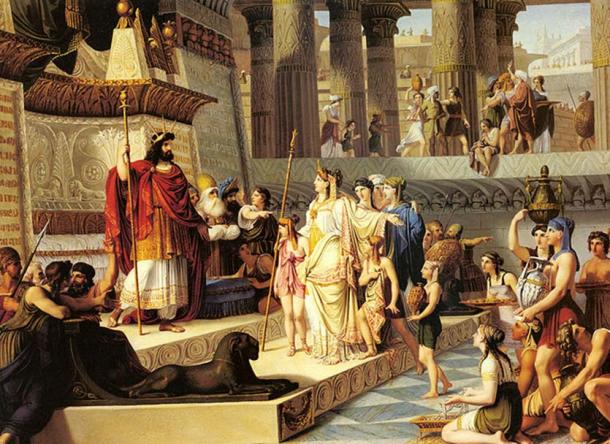
‘Solomon and the Queen of Sheba’ by Giovanni Demin. (Public Domain)
“Steadying herself on Solomon’s arm, she bent down, and removing her sandals modestly lifted the hem of her robe, and stretched out a toe to test the water. The King was taken back with surprise, fooled automatically into a momentary belief that she really did believe a river in some way flowed through the hall.
Now it was his turn to express confusion.
“It isn’t water. They are only glass tiles.” Then he saw that she was only teasing, and stammered, “Well, some of my guests have thought it very true to life. But it is well done isn’t it?” (The Tutankhamen Code.)
- The Legendary Queen of Sheba and Her Iconic Visit with King Solomon
- Grimoires by a Biblical King? The Magical Treatise of Solomon and the Key of Solomon
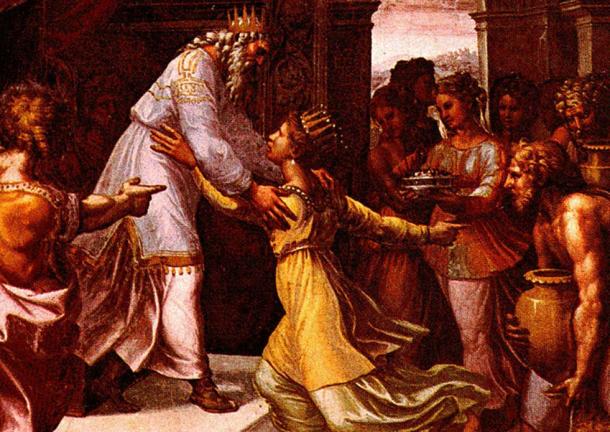
‘The Queen of Sheba.’ (Public Domain)
Finding Solomon’s Temple and Palace
Fragments of glazed tiles depicting water, fish, reeds and birds have only ever been found in the ruins of one ancient Palace, that of Ymn Htp III at Malqata near Luxor.
This fact, along with a number of other finds in Luxor, are examined in “Out of Egypt” by the British/Egyptian historian Ahmed Osman and every-one of them points only to one man as having been the legendary King Solomon, namely the Pharaoh YmnHtp III.
We are told in the Book of 1 Kings that Solomon’s Temple and Palace were so grand and sumptuous that there has to be some archaeological evidence for them - yet nothing has ever been found in modern day Israel despite umpteen digs over more than a hundred years. The fabulous remains in Luxor not only match all we are told in the Bible, but many of the ancient walls and columns still stand, shouting out their message that these were built by the 18th Dynasty Kings David and Solomon, otherwise known in Ancient Egypt as Dayhut and Salim Amen.
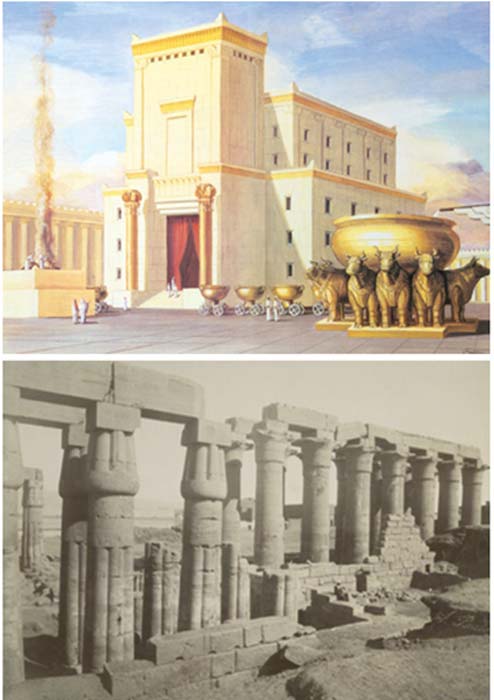
Top: Artistic interpretation of Solomon’s Temple (CC BY 4.0). Bottom: Temple of Amenhotep III, Luxor, Egypt. (Public Domain)
I can only put the blindness of those who do not see down to a religious zeal that just will not allow any belief that the Bible time-line is out by four centuries or that Israel was once a large part of Egypt, a country that they have been taught to hate, even though the Bible itself places Israel in Egypt in the Book of 1 Samuel.
Solomon and Sheba: Pharaoh Ymn Htp III and Queen Etiye Azeb
Ahmed Osman not only identified both Kings but also Solomon’s father-in-law, Joseph. The evidence is so extensive that there cannot be any doubt about either of them. The full details of such proof can be studied in Osman’s books and, if one prefers a lighter approach, in my novel The Tutankhamen Code.
Apart from some 13 facts pointed out be Ahmed Osman which match quite precisely all we are told in the book of 1 Kings I have been fortunate in recognizing 11 more. When these are also taken into account then not one iota of doubt can remain. Solomon was the Pharaoh Ymn Htp III and the love of his life was his Queen Etiye Azeb, better known to us as Sheba. Here are a few of the most significant matches of my own finds with the Bible account.
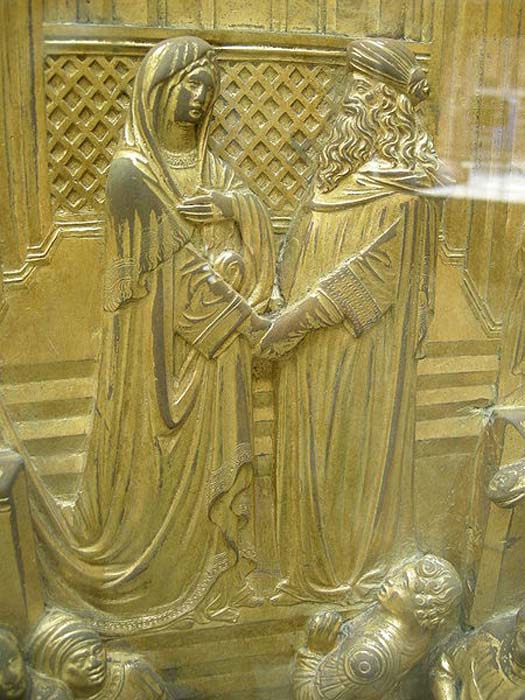
Solomon and the Queen of Sheba (Gates of Paradise). (Sailko/CC BY 2.5)
It was the Greek Egyptian historian Manethos who wrote, “Thus it came about that 80,000 unclean individuals were rounded up and dispatched to the stone quarries”. This is the same figure given in 1 Kings 5:15. The term ‘unclean’ was used to denigrate anyone not conforming to the writer’s own religious beliefs.
In year 10 of Solomon’s reign he married a foreign princess named Gilukhepa and a Marriage Scarab was issued with these words, “Gilukhipa, persons in her harim: 317 women”. 1 Kings 11:3 gives it as 300 concubines, a very close match.
- How is the Fallen Kingdom of Aksum Connected to the Queen of Sheba and the Ark of Covenant?
- King Solomon’s Mines Discovered: Kings and Pharaohs - Part I
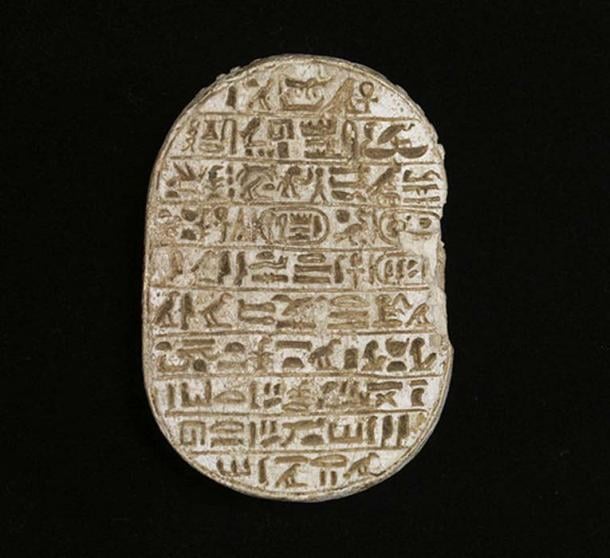
A commemorative scarab of Amenhotep III. This scarab belongs to a class called the "marriage scarabs," which affirm the divine power of the king and the legitimacy of his wife, Tiye. Walters Art Museum, Baltimore. (Public Domain)
The Bible tells us that Solomon’s father was King David. The father of Ymn Htp III was actually named in separate hieroglyphs as DHWT, which has to be the same for it would have been spoken something like ‘Dayhut’. A shortcut hieroglyph was occasionally used, hence a different translation of ‘DJHWT’. Like many other names this sometimes had the letter ‘Y’ added on the end just as we do in English and another suffix ‘Ms’ simply meant ‘Born of’.
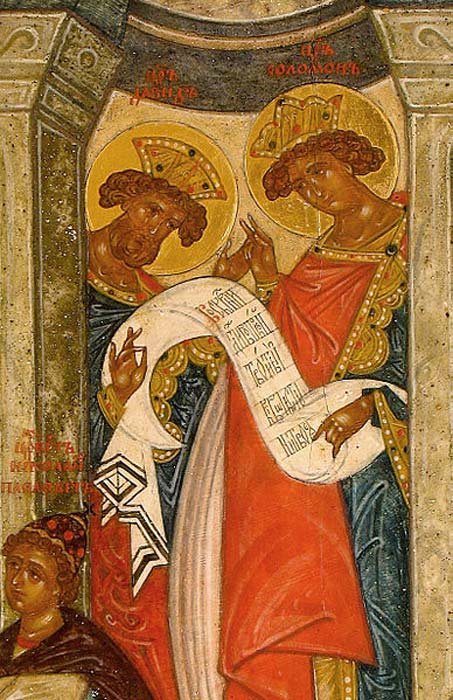
David and Solomon. (CC BY SA 3.0)
The Kebra Nagast names MenyELEk as the eldest son of Solomon and that he was also known as David. MenyELEk has the very same meaning as YmnTwtAnkh, better known today as ‘King Tut’.
The Hall of Columns at Malqata, Luxor has the same length and breadth as the measurements given in 1 Kings 7:6, within two to three centimeters.
The clincher is in his name Ymn Htp III. Ymn, the God name for the setting Sun in the West was always written as ‘AMEN’, even in Greek letters, by Manethos who was still versant with the old Egyptian language. Hetep or Hotep was the Egyptian word for Peace or Rest, which at that time in Hebrew was Salim. As a Hebrew King of Egypt, his own family and his own people would have called him Salim Amen which evolved into Salomon then Solomon. Foreign Kings ruling other countries speaking other languages and for many generations is not that unusual. Guillaume I of England is a case in point as is Georg I of England (who never spoke English.)
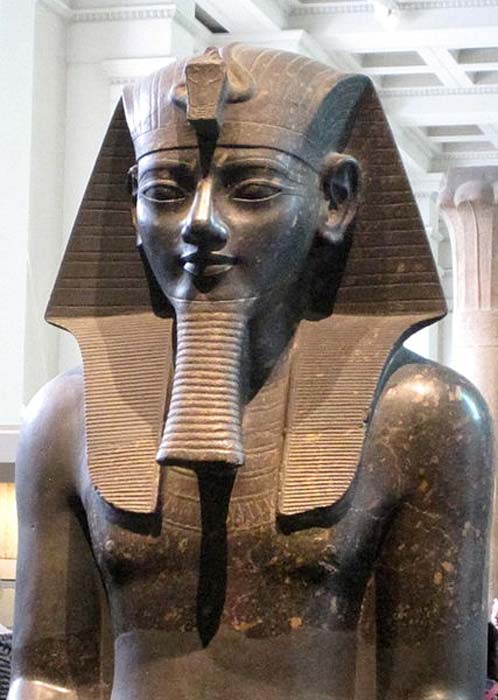
Colossal statue of Amenhotep III in the British Museum. (Public Domain)
Robert Feather in his “The Mystery of the Copper Scroll of Qumran” suggests that the Egyptian word ‘Heprew’ is the origin of the name Hebrew and this has to be true for the hieroglyph for Heprew (Creations) was a Scarab Beetle - in Greek ‘Scarabaeus’ - and this is what St. Ambrose called the mythical Ever Coming Son, IWSA - Iesous - in the 4th century AD.
More Evidence on Solomon and Sheba’s True Identities
Ralph Ellis tells us in his “Jesus Last of the Pharaohs” that the names of Biblical patriarchs are nearly all those of other Egyptian Kings and some are even spelled exactly the same such as the Pharaoh Jacob. But there were also Kings called Joshua, Abel, Cain, Abram, Salah, Isaac, as well as Jacob, David, and Solomon.
Ahmed Osman also notes in his book that both the Koran and Jewish traditions have it that Joseph’s brothers entered the City by different gates. Ancient Thebes, now Luxor, was renowned for its many Gates and Pylons and there wasn’t another city in those days that could compare.
It is quite surprising that not one Egyptologist has ever noticed the legend found by Sir Wallis Budge which tells us that Solomon’s Queen was an Abyssinian girl named Eteye Azeb and then realized that the name of Ymn Htp III’s Queen they translate as ‘Tiye’ should begin with an ‘E’. This vowel was never written in Egyptian but we now know that it was from the Ethiopian spelling. Syllables were often reversed in writing so Azeb has to be Zeba or Sheba. The Kebra Nagast even tells us that Solomon and Eteye’s son was called Meny EL Ek and that he was also known as ‘David’ which is ‘Dwd’ in Hebrew and ‘Twt’ or Tut in Egyptian. Both EL and TWT were seen as Moon Gods, which explains the variation from Ymn Twt Ankh to Meny EL Ek.
- Tiye: One of the Most Influential Women of Ancient Egypt
- Dazzling Nebmaatre: Amenhotep III and the Age of Opulence—Part I
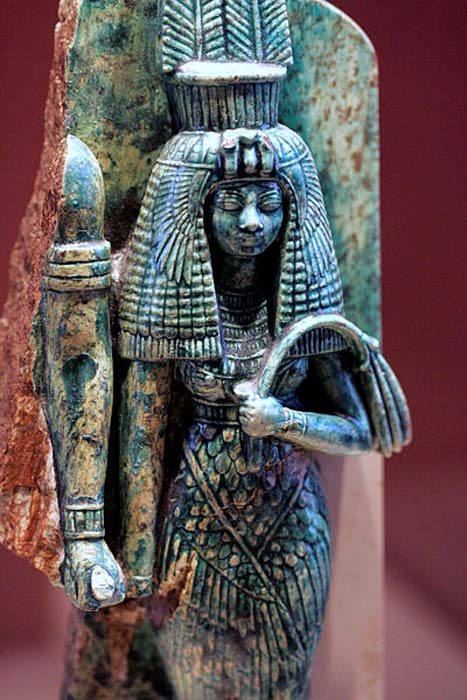
Queen Tiye. Her husband may have been depicted to her right in this broken statue. (Rama/CC BY SA 2.0)
We do know that the mother of Etiye, namely Tuya or Etuya, the wife of Joseph, came from the south and what is today Northern Sudan. That places a question mark over the lovely story told by Ahmed Osman about Ymn Htp having a pleasure lake built for Etiye at Zarw and presenting her with a Summer Palace. The loving Royal Couple ‘sailed thereon in the Royal Barge ‘Aten Gleams’. Osman then places Zarw as being somewhat east of the Suez Canal, which would have been close to her Israelite relatives in Goshen.
A Question of Location
The problem with that location is that the King did build a lake in front of her Palace at Malqata, with a ‘T’ shaped channel running from the Nile at Luxor and terminating in a large harbor by the Palace. A marriage scarab commemorating this wonderful gift from the King to his wife gives its length as 3,700 cubits (about 1,020 yards), and breadth about 700 cubits. One kilometer is 1093.61 yards, which is near enough the same.
Today a long line of hills marks the route of the Channel from the Nile to Malqata, each one once topped with a glorious shining Temple. Truly a Gift of Great Love.
Top Image: The visit of the Queen of Sheba to King Solomon. Source: jerry dognal/ CC BY NC ND 2.0
Updated on August 25, 2021.
















Comments
King Tut, Tutankhamun, is believed to have been the grandson of Amenhotep III. His father is believed to have been Akhenaten, the king who was disliked because he changed the religion of Egypt. The remains of Tutankhamun's father and mother have been identified through DNA testing. KV55 contained his father's mummy. The mummy known as The Younger Lady was identified as his mother, as well as the sister of his father. Amenhotep III was the father of Akhenaten.
What is also more striking is that Meny EL Ek The son of Solomon mentioned here sound similar to Menelik first Solomonic Emperor of Ethiopia and son of Solomon from queen Sheba